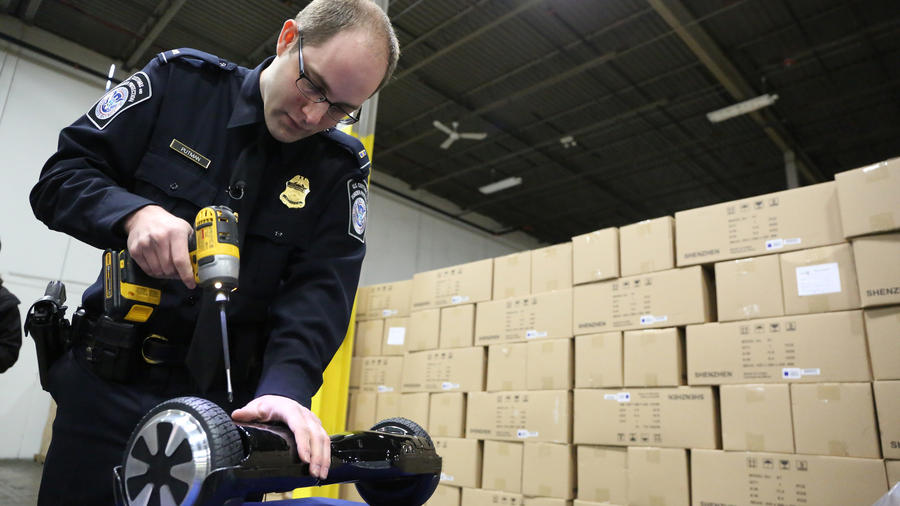
U.S. Customs and Border Protection’s Chicago field office has seized more than 16,000 hoverboards, worth about $6 million, after finding that they posed a health risk and used trademark logos without authorization.
The two-wheeled, motorized boards — which are powered by lithium-ion batteries — have reportedly caught fire while users were charging or riding them. Many of the hoverboards seized by the Chicago field office came from China and have false seals of approval from Northbrook-based Underwriters Laboratories, which tests products for safety and certification.
William Ferrara, director of field operations for the Chicago Customs and Border Protection office, said the fake UL markings give consumers a “false sense of security.” Some of the hoverboards also had counterfeit Samsung logos.
“The batteries do not meet safety standards, and the chargers as well,” Ferrara said at a news conference Wednesday. He said some chargers don’t shut off automatically when the batteries are finished charging, which could lead to an explosion.
The U.S. Consumer Product Safety Commission is investigating at least 40 reports of fires related to hoverboards in 19 states. It is also examining the safety of boards from 13 manufacturers, importers and distributors. Commission staff are specifically looking at the components and design of battery packs and circuit boards.
Some Illinois universities have banned or restricted the use of hoverboards on their campuses. Metra and U.S. airlines have prohibited the devices as well.
Ferrara stood in a warehouse in Bensenville in front of rows and rows of stacked cardboard boxes containing the hoverboards. And those accounted for only about half of the hoverboards the office has seized. The others were held in another part of the building and in a second warehouse.
On one box, the label said the item’s shipper was in Shenzhen, China. Under consignee, a Miami address was listed. The package apparently departed from Hong Kong and was sent to O’Hare International Airport.
Some hoverboards came from an ocean container, while others were discovered in air shipments, Ferrara said. A number of shippers and importers were involved. “Due to the work of our officers and import specialists, word got around the smuggling community,” and shipments to Chicago have stopped, he said.
“Quite frankly, it came down to good, old-fashion officers going out, opening up boxes based on their knowledge and realizing that something wasn’t right here,” Ferrara said. Officers worked with trademark owners to determine whether markings were real.
“They use every different thing they can,” customs spokesman Kris Grogan said. “Some of them will just be cheap knockoffs, while others will be trying to come in under a fake name.”
Hoverboards, which don’t actually hover in the air, became a popular holiday gift item in 2015. Riders stand on the board, which has a single wheel on each side, and shift their weight to make it move. Some can cruise at 10 or 12 mph.
Customs and Border Protection is calling the number of seized hoverboards a record for the nation. The office still has more shipments to process, which will make the total even larger. The counterfeit hoverboards will be destroyed, Ferrara said.
Officer James Putman took apart a hoverboard and showed how it looks inside. Within the black board was thin plastic sheeting that held 24 cylindrical lithium-ion batteries, Putman said. The batteries were stacked together and hard-wired to a circuit board. He said most hoverboards he’s seen have similar configurations.
The inside also had a Samsung marking, which made it appear like the company had approved or made the batteries.
“I’ve opened some very expensive hoverboards with the exact same configuration who have also violated trademarks,” Putman said. “So just because you spent more doesn’t necessarily mean it’s safe. It might have come in fancier packaging and they put a glossier finish on it, but it still could be constructed in an unsafe manner and could still be violating trademark.”
Putman suggested that shoppers take a look at a hoverboard’s power adapter before they buy it. If the power adapter has a UL mark, he recommends noting the file number and searching for it on UL’s online certifications directory. Putman said consumers should also check whether the battery pack is well-anchored.






